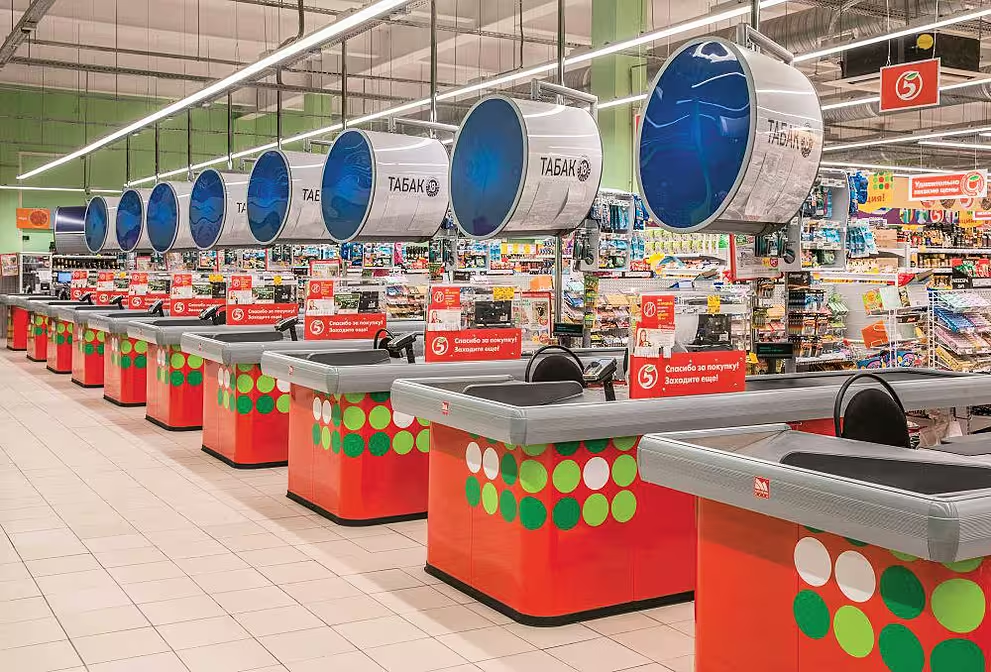In the run up to Christmas 2018, ESM is proud to present a recap of some of our biggest articles of the year, exclusively for Premium website subscribers. In Issue 6, Ben Webb met Sergei Goncharov, general director of Pyaterochka, the 12,800-store convenience arm of Russian retail giant X5 Retail Group. This article first appeared in ESM Issue 6 2018.
Sergei Goncharov, the general director of Pyaterochka, X5 Retail Group’s chain of proximity stores, was in London for a Capital Markets Day last month, to help the huge chain continue its expansion, despite challenging market conditions. During his visit, Goncharov also found time, he noted, to take his son to Harry Potter World.
I wondered, as he looked at me with a relaxed smile, if there was something of the magician about Goncharov and his plans for the massive retail banner.
A magic wand would certainly be handy in the Russian grocery business, which is undergoing a process of consolidation after a long period of rapid growth and expansion. It is a fascinating story, tied to the transformation of the managed economy of the Soviet Union into a buoyant, bustling, ambitious and highly competitive market-driven world.
Emerging Market
“There was no Russian grocery market, in a sense, until 1990,” Goncharov explains. “The state-controlled system created shortages, out-of-stocks and deficits. Choice was limited. The arrival of capitalism led to a remarkable change in grocery, with two key phases: demand fulfilment, and then demand creation.”
Initially, the population was desperate for more choice and more brands, and the emerging grocery players faced a logistical battle to create networks that could reach a disparate and widespread population. The grocers expanded rapidly. The Russian retail space race had started.
“It was simple,” Goncharov points out. “If you could put stuff on shelves, you were in business.”
That expansion phase ran until about 2015, he believes.
“The market became a little saturated, and you started having to think about the customer, so demand creation started. Now, the competition is to focus on the customer and understand what they want and the best way to satisfy them. It is about building long-term loyalty. Every day we have to be better than yesterday,” Goncharov says.
From Small Beginnings
X5 Retail Group was formed as a result of the merger of the Pyaterochka and Perekrestok retail chains in 2006 and, as with many of its competitors, grew rapidly. Last year, it reported total revenues of RUB 1,295.0 billion (€17.31 billion) and a net profit of RUB 31.4 billion (€420 million). In the third quarter of this year, total net retail sales were up 17.6% year on year, driven by a 0.5% rise in like-for-like sales and a 17.1% rise from an increase in selling space (by 19.6%).
X5 operates three main brands: Pyaterochka, Perekrestok and Karusel. Goncharov is the general director of Pyaterochka, the largest of the three chains, which boasts a mammoth 12,822 stores (as of this September) with an average size of 393 square metres. The stores, which are located in residential areas, offer value on a range of goods for everyday needs and top-up shopping.
Perekrestok, in contrast, offers a premium shopping experience in central city locations and traffic hubs, where it has a focus on high-quality, fresh, exotic and unique products. Karusel, meanwhile, is a destination store for large-scale purchases of food and household goods.
Under Goncharov’s leadership, Pyaterochka’s formula continues to be successful. In the third quarter this year, the chain grew net retail sales by 18.4%, to hit RUB 297.9 billion (€3.96 billion), which accounted for almost 80% of X5’s profits. Returns have been maintained despite expansion – 5,000 new stores (net) in two years – and a refurbishment programme. Importantly, the perception of the brand has improved, too.
“People are choosing convenience over big-box because time has become one of their biggest assets,” says Goncharov. “As society matures, people don’t have time to go to the big store, and that’s why we expect further growth in the future. We want to open around 1,800 stores next year – and that’s a lot – but we are not just focused on growth. We are looking at a more balanced approach.”
In some ways, the hard work starts now. To maintain growth, Pyaterochka needs to increase its focus on extracting more from each customer, rather than merely adding new stores. Welcome to the era of customer-centricity and demand creation.
There are three elements to Pyaterochka’s strategy: boosting its customer value proposition, operational efficiency, and innovation. It is no longer a pedal-to-the-metal bid to speed up growth, but a far more sophisticated, multilayered strategy that is based on learning more about the customer and what he or she really wants, when he or she wants it, and what he or she might want in the future.

The Loyalty Game
A vital part of the customer-centricity drive is gathering data about the customer, and the Pyaterochka loyalty card is already starting to deliver valuable insights that are helping in the planning of pricing and promotions. As Goncharov explains, Pyaterochka is putting more focus on rewarding very loyal customers, rather than trying to attract new ones. The logic makes sense.
Pyaterochka breaks its customers down into most loyal, loyal, and those without cards. The ‘most loyal’ 10% account for 40% of revenue. With each increase of 1% in the ‘most loyal’ group, there is a 2.7% revenue increase, hence more targeted initiatives that encourage loyal customers.
“I think a target of 15% for ‘most loyal’ is reasonable,” Goncharov adds. “We want to reward the most loyal customers.”
To enhance the drive towards omnichannel, an online service is also in the pipeline. Sister company Perekrestok has already launched its online business in 2017, which currently operates the Moscow region and St Petersburg, with two dark stores and a hybrid store. The dark stores will employ around 600-800 people each, and will handle over 20,000 SKUs at their full capacity.
“Online is certainly an area that we are looking at,” Goncharov says. “We want to launch online next year. The business model for online groceries is a hard nut to crack. As far as I know, nobody has been able to do online profitably yet, but it is a vital part of our drive to be the most customer-centric company in Russia.
“If the customer wants to buy online because they are time-pressed, then we will give them online shopping, especially in the urban areas – Moscow and St Petersburg, for example.”
Retail technology is similarly advancing at a remarkable rate, and Goncharov, who formerly worked for Sony PlayStation, wants to ensure that Pyaterochka is leading the market, rather than following it. It has opened a so-called ‘lab store’ in Moscow, to test new technologies such as electronic shelf labelling, video analytics, smart shelves, digital information panels, and self-scanning and self-checkout systems.
There’s also a drive to improve own-brand penetration. A dedicated team is being created to review the range and boost private label’s share of sales from 14% to more than 20% over the next three years.
Corporate Framework
As ever with retail, the devil will be in the detail as greater efficiencies are sought, which is very much aligned with Goncharov’s overall management philosophy. Armed with an MBA from Wharton School of Business, Finance and Accounting, he not only wants to understand his customers better, he wants to build a corporate framework designed to ensure that the service it delivers is as good as it can be.
“The store is the weakest link in the whole of the chain, and as the weakest link, it’s the focal point of our strategy,” he explains.
“When I talk about the customer as the most important issue for us, I’m not only talking about our outside customers – we also have our internal customers, our employees.
“If there is a problem on the supply side, getting product to the customer, it can be pushed from the distribution centre, to the logistics chain, and on to the shop. When you get to the shop, there is nowhere to push. Customers will be dissatisfied and go to the competitor. We have to work in reverse and start with the shop, rather than end with the shop.”
Maintaining a positive and happy staff roster, therefore, is one of Goncharov’s key objectives. New incentive schemes are being rolled out. He wants to encourage a lower turnover of personnel and, by extension, greater loyalty and work satisfaction.
“The heart of it all is increasing our customer focus through deeper customer understanding, but also more positive employee engagement,” he says. “We cannot give good service to our customers if our employees are unhappy.
“I believe in fair treatment and paying people according to the work they do.
“Your boss should treat you like a human, and not yell. People are social animals and enjoy a feeling of belonging to something that is bigger than them. To enjoy work, you need two things: meaningful work and meaningful relationships. That’s what we want to give to them.
“As Chekhov said, ‘A person who has a bad tooth will not think about his motherland,’” he adds with a smile.

Management From The Bottom Up
Devolving decision-making to more a local, regional level is part of the process and something of an essential move, given the rapid growth of the company.
Six new subregions have been created, while head office is now very focused on supporting the regions with guidance about methodology and store design research.
Fewer management decrees are pronounced from on high, and more responsibility has been passed on to local or regional managers.
Goncharov cites the example of Toyota’s management philosophy, which aimed to empower workers on its production line. Teams learned to solve problems together. Such a move was expensive initially, but proved immensely efficient.
“That’s what we want to do with our stores,” Goncharov explains, “even if it means that sometimes we have to be somewhat slower than the others.”
The new structure will also make the company more responsive to consumer demand and its 40 million customers. He now feels ready for battle with the competition in a challenging market.
“Today’s Russian consumers have as much access to information as the rest of the developed world and are just as hungry for choice,” Goncharov says. “Competition is healthy and keeps you on your toes. We embrace it.
“I’m a big football fan, and in football, you need a strong bench so those on the pitch – even a Messi or Ronaldo – don’t get lazy. Our team has gone through a transformation – 11 of the 15 managers who report to me are internal appointments – and things are starting to click.
“Now the magic happens.”
© 2018 European Supermarket Magazine – your source for the latest retail news. Article by Ben Webb. Click subscribe to sign up to ESM: The European Supermarket Magazine.














